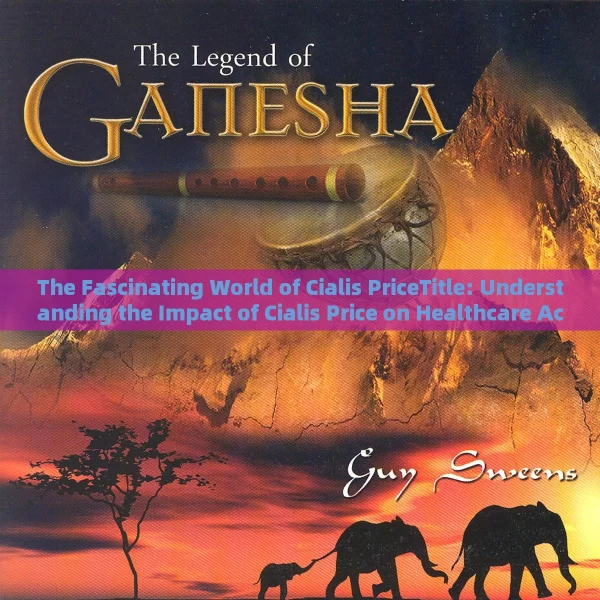The Fascinating World of Cialis PriceTitle: Understanding the Impact of Cialis Price on Healthcare Accessibility
Cialis is a well-known medication that has gained significant popularity in the field of erectile dysfunction treatment. The price of Cialis is a crucial factor that influences the accessibility and affordability of this medication for many individuals. In this article, we will explore the various aspects related to Cialis price, including its determinants, market trends, and the impact it has on patients.

The importance of understanding Cialis price cannot be overstated. It allows patients to make informed decisions about their healthcare and manage their budgets effectively. Additionally, it plays a role in the overall healthcare system, as it affects the affordability and availability of essential medications.
To understand Cialis price, it is essential to consider several factors. These include the cost of manufacturing, research and development, marketing, and distribution. The price may also vary depending on the dosage, formulation, and the region where it is sold.
Market trends in Cialis price can be influenced by various factors, such as competition, supply and demand, and changes in healthcare policies. For example, the introduction of generic versions of Cialis can often lead to a decrease in price, making the medication more accessible to a wider range of patients.
The impact of Cialis price on patients is significant. Higher prices may pose a financial burden, especially for those without adequate insurance coverage. This can potentially limit their access to the medication and affect their quality of life. On the other hand, lower prices can increase affordability and improve treatment adherence.
To illustrate the importance of Cialis price, let's consider a real-life case. A patient with erectile dysfunction may struggle to afford the medication due to its high cost. This could lead to a delay in seeking treatment or even forgo it altogether, which can have negative consequences on their sexual health and overall well-being.
In conclusion, the price of Cialis is a complex and important topic that deserves attention. By understanding the factors that influence it and the impact it has on patients, we can work towards making this medication more accessible and affordable. Future efforts should focus on increasing competition, improving healthcare policies, and exploring alternative treatment options to ensure that individuals have the opportunity to receive the care they need. Remember, the keyword "Cialis price" is crucial in this context, as it highlights the central theme of our discussion.
In today's world, healthcare accessibility is a crucial issue that affects millions of people globally. One of the key factors influencing this aspect is the price of medications, particularly those used to treat chronic conditions like erectile dysfunction. Cialis, a popular drug in this category, has seen its price fluctuate over time, raising questions about its impact on healthcare accessibility. This article aims to explore the significance of Cialis price and its implications for patients and healthcare systems worldwide.
Cialis, also known by its generic name tadalafil, is a medication primarily prescribed to treat erectile dysfunction. It works by relaxing the muscles in the walls of blood vessels in the penis, allowing increased blood flow and resulting in a more firm erection. Since its launch in 2003, Cialis has become one of the most widely used treatments for erectile dysfunction due to its long-lasting effects and relatively few side effects.
However, the price of Cialis has been a topic of concern for many patients and healthcare providers alike. The cost of the drug can vary significantly depending on factors such as dosage, location, and insurance coverage. In some cases, the price of a single pill can be prohibitively high, making it difficult for some individuals to afford their medication. This situation raises several important questions about the impact of Cialis price on healthcare accessibility.
Firstly, the high cost of Cialis may prevent some patients from accessing the treatment they need. A study published in the Journal of Sexual Medicine found that nearly half of all men with erectile dysfunction did not seek medical help due to concerns about the cost of treatment. This suggests that the price of Cialis could be a significant barrier to effective care for many individuals.
Secondly, the price of Cialis may also have broader implications for healthcare systems. If patients are unable to afford their medication, they may be forced to rely on less effective treatments or even go without any treatment at all. This can lead to poorer health outcomes and increased costs for healthcare providers in the long run. Additionally, the financial burden of high medication prices can strain healthcare budgets and limit resources available for other important areas of care.
To address these challenges, several strategies have been proposed to make Cialis more affordable for patients. One approach is through price negotiations between pharmaceutical companies and insurers. By negotiating lower prices for medications like Cialis, insurers can help reduce out-of-pocket costs for patients and improve access to necessary treatments. Another strategy is through the development of generic versions of the drug, which tend to be less expensive than branded options.
In conclusion, the price of Cialis plays a significant role in determining healthcare accessibility for individuals with erectile dysfunction. While the drug has revolutionized the treatment landscape for this condition, its high cost may prevent some patients from accessing the care they need. To improve healthcare accessibility, it is essential to implement strategies that make Cialis more affordable for patients while ensuring that healthcare systems can continue to provide high-quality care to those in need. As we move forward, it will be important to monitor the impact of these efforts and adjust them as needed to ensure that all individuals have equitable access to necessary treatments.
viagra madrid